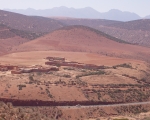
The buildings and estates in the mountains near Ifni are generally like fortresses. Four adobe, or mud, walls with two or four towers also made of mud, trapezoid walls with wide basis and the tower with the shape of a pyramid.
To enter the house, there is a door with a kind of interior “burladero” so ,when it opens, nothing can be seen from outside and, the most important, to force people to go in one by one, for security purposes. There are also many rock-made houses in the mountains, because rocks are more resistant than the mud but inside surfaces of the rooms are covered with mud.
The patio, is generally crossed by two walls, in “X” shape, dividing it into four patios. The different rooms are built against those walls; the lights towards the patio and never towards the exterior. There’s an ample room for the visitors, rooms for the man of the house, for the woman and other members of the family and rooms for goods and grains. In one of the patios, the cattle is gathered at night. The rooms are three meters high and they are covered by “argán” beams and sticks. On top, there is rolled soil; as it seldom rains in the country, this is enough. The towers and some walls are sometimes battlemented for defensive purposes.
As the family grows, and the sons and daughters get married, new rooms are added or built next to the parents’, so there is a group of buildings for each family. Thus, the villages in Ait Ba Amrán are never crowded together, everything is diperse in small groups. These types of buildings, like forts, had many advantages in times of insecurity, as each family could easily defend against external danger.
Another advantage, is the easy isolation in case of epidemics. Nowadays, when countagious diseases are detected, doctors isolate the group of houses, avoiding the propagation. The Baamranis construct their houses with “Luh”. This word means mould, but due to generalization, it has become the name of the constructive system. The hardness and resistance that the soil acquires depends on the time of its maturing, whether the soil was picked beforehand and, whether water was poured during 25 days; or put directly into the mould, or “Luh”, in which case water must be poured during 45 days. The Baamranis workers’ sense of smell tells the exact time of maturing. After 25 or 45 days, the soil in the mould, rolled and flattened, has the shape of a brick. Walls are built by piling up the bricks. The different kinds of houses are:
The “Tagadirt”, fort house, was generally owned by a rich and important family, usually with political influence in a certain region. In this fortress, the neighbours took shelter in times of battles and they became part of the defense. In this construction, the tower protects the house. The walls continue in front of the tower till the front wall, forming a wide patio.
Some kinds of “Tagadirt” have two towers, increasing its defensive power. They are located in opposite vertices, and they have loop holes in the four directions.
The “Agadir”, fort house built with the effort of several families within the kinship, to defend themselves against thieves. All the houses are built inside a rectangular enclosure. Heading the construction, is the tower or “borch”. It’s a small fortified area with several patios and its own cistern. There’s a terrace surrounding the buildings. The tower is usually built in one of the corners.
The “Kasbah” is the real fort, square or rectangular shaped and usually built on a hill. It is composed by towers, walls, patios, roads and mazes, and interior houses. It usually has eight towers.
The “Tignemmi” or house, is the rural housing in the plain. It has different characteristics depending on the owners, whether they are rich or not.
The “Jaima” or tent, is made of dromedary or goat leather. It can be usually seen in Ifni, as it is a land of transition, it is also a stopover region.